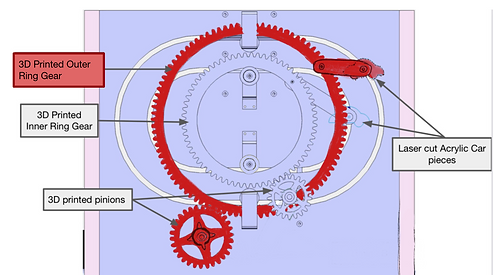SolidWorks CAD Model
We began paving our solution using SolidWorks CAD models and continued to add and edit as our ideas raced along to the finish line. Using our CAD design, we were also able to conduct any necessary FEA and various calculations as we continued our prototyping progress
Phase 1: Concept Sketch to first CAD model


For our first CAD model, we focused on creating a preliminary transmission system from the user's wheelchair motion to the gameboard pieces.
Upon gaining inspiration from the Invictus Wheelchair trainer, we implemented a similar concept of using rollers that would be spun by the wheelchair wheels to transmit power to the mini-car pieces on the gameboard
In this model, we came up with our first gameboard transmission design involving a
circle-link mechanism that moved the car about the oval racetrack
Phase 2: Final CAD model


For our second and final model, we added a second track in order to make our game for two players, as the our original sketch had intended. We also added a finish line and tunnel to hold our two inner pieces in place.
With the addition of a second track, we realized that our original circle-link mechanism would create some some fender benders, as our two car shafts and links would collide with each other.
As a result, we came up with a modified version of our gameboard transmission design
and implemented a ring gear and pinion system, involving an inner and outer
gear that were respective to the inner and outer track system
w
Game-board Mechanism
In order to avoid our car shafts from colliding into each other, we modified our original circle-link mechanisms to a ring gear and pinion system.
For this design, we have a large outer ring gear connected to the outer car link and track (as shown above in red). We then have a thicker inner ring gear system to power the inner car and track system (as shown in blue).
Both these gears will then be powered individually by pinons that are connected to their respective timing belts powered by a set of rollers that can be spun by the wheels of the user's wheelchair.
User Experience
The user will wheel themselves up a ADA approved ramp onto the wheelchair platform
Once on the platform, the user will then back themselves onto a set of rollers
The user can then spin their wheels in order to power their game-board piece
Through this system, we not only accomplished our goal to encourage peer-to-peer interaction in the competitive nature of this solution, but we also were able to incorporate the wheel-chair motion into the game itself in order to create an easily accessible structure that empowered children of all abilities.

